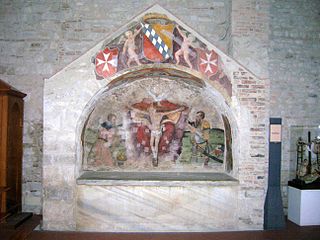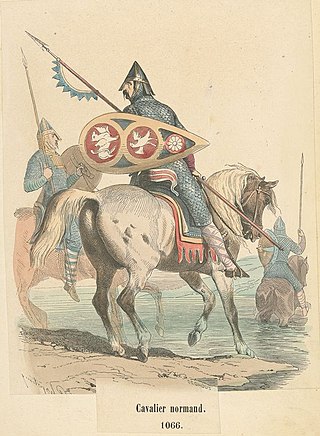
The Duchy of Benevento was the southernmost Lombard duchy in the Italian Peninsula that was centred on Benevento, a city in Southern Italy. Lombard dukes ruled Benevento from 571 to 1077, when it was conquered by the Normans for four years before it was given to the Pope. Being cut off from the rest of the Lombard possessions by the papal Duchy of Rome, Benevento was practically independent from the start. Only during the reigns of Grimoald and the kings from Liutprand on was the duchy closely tied to the Kingdom of the Lombards. After the fall of the kingdom in 774, the duchy became the sole Lombard territory which continued to exist as a rump state, maintaining its de facto independence for nearly 300 years, although it was divided after 849. Benevento dwindled in size in the early 11th century, and was completely captured by the Norman Robert Guiscard in 1053.

William I of Hauteville, known as William Iron Arm, was a Norman adventurer who was the founder of the fortunes of the Hauteville family. One of twelve sons of Tancred of Hauteville, he journeyed to the Mezzogiorno with his younger brother Drogo in the first half of the eleventh century (c.1035), in response to requests for help made by fellow Normans under Rainulf Drengot, count of Aversa.
Argyrus was a Lombard nobleman and Byzantine general, son of the Lombard hero Melus. He was born in Bari.

Guaimar IV was Prince of Salerno (1027–1052), Duke of Amalfi (1039–1052), Duke of Gaeta (1040–1041), and Prince of Capua (1038–1047) in Southern Italy over the period from 1027 to 1052. He was an important figure in the final phase of Byzantine authority in the Mezzogiorno and the commencement of Norman power. He was, according to Amatus of Montecassino, "more courageous than his father, more generous and more courteous; indeed he possessed all the qualities a layman should have—except that he took an excessive delight in women."

Pandulf I Ironhead was the Prince of Benevento and Capua from 943 until his death. He was made Duke of Spoleto and Camerino in 967 and succeeded as Prince of Salerno in 977 or 978. He was an important nobleman in the fight with the Byzantines and Saracens for control of the Mezzogiorno in the centuries after the collapse of Lombard and Carolingian authority on the Italian Peninsula. He established himself over almost the whole of the southern half of Italia before his death in March 981. He was an ancestor of Sancho I.
Rainulf Drengot was a Norman adventurer and mercenary in southern Italy. In 1030 he became the first count of Aversa. He was a member of the Drengot family.

The Duchy of Gaeta was an early medieval state centered on the coastal South Italian city of Gaeta. It began in the early ninth century as the local community began to grow autonomous as Byzantine power lagged in the Mediterranean and the peninsula due to Lombard and Saracen incursions.
Guaimar III was the Lombard prince of Salerno from around 994 to his death. Under his reign, Salerno entered an era of great splendour. Opulenta Salernum was the inscription on his coins. He made Amalfi, Gaeta and Sorrento his vassals and annexed much of Byzantine Apulia and Calabria.
Arduin the Lombard was a Greek-speaking Lombard nobleman who fought originally for the Byzantines on Sicily and later against them as the leader of a band of Norman mercenaries.
Landulf II, called the Red, was the Lombard prince of Benevento and prince of Capua from 939 or 940, when his father, Landulf I, first associated him with the government. His mother was Gemma, daughter of Athanasius of Naples. He may have been associated as early as 933, when his elder brother, Atenulf III, was made co-regent. His uncle Atenulf II died in 940 and it is likely that Landulf served as a replacement. Landulf married Yvantia on an unknown date.
Landulf V was the prince of Benevento from May 987, when he was first associated with his father Pandulf II, to his death. He was chief prince from his father's death in 1014.
Pandulf III was the prince of Benevento in the Mezzogiorno in medieval Italy, first as co-ruler with his father, Landulf V, and grandfather, Pandulf II, from between 1012 and 1014, when the elder Pandulf died. He co-ruled with his father until his death in 1033. Thereafter he was the primary ruler until his abdication in 1059.
Landulf VI was the last Lombard prince of Benevento. Unlike his predecessors, he never had a chance to rule alone and independent. The principality lost its independence in 1051, at which point Landulf was only co-ruling with his father, Pandulf III.
Exaugustus Boiοannes, son of the famous Basil Boioannes, was also a catepan of Italy, from 1041 to 1042. He replaced Michael Dokeianos after the latter's disgrace in defeat at Montemaggiore on May 4. Boioannes did not have the levies and reinforcements that Doukeianos had had at his command. He arrived only with a Varangian contingent. Boioannes decided on trying to isolate the Lombard rebels in Melfi by camping near Montepeloso.

The Principality of Capua was a Lombard state centred on Capua in Southern Italy. Towards the end of the 10th century the Principality reached its apogee, occupying most of the Terra di Lavoro area. It was originally a gastaldate, then a county, within the principality of Salerno.

The Norman conquest of southern Italy lasted from 999 to 1194, involving many battles and independent conquerors.

The Battle of Olivento was fought on 17 March 1041 between the Byzantine Empire and the Normans of southern Italy and their Lombard allies near the Olivento river, between the actual Basilicata and Apulia, southern Italy.
The Battle of Montepeloso was fought on 3 September 1041 between Lombard-Norman rebel forces and the Byzantine Empire, near Montepeloso in southern Italy. The Byzantines, led by Exaugustus Boioannes, were forced into battle by the rebels, and after a day-long fight the rebels defeated the Byzantine army and captured Boioannes. The decisive rebel victory forced the Byzantines to retreat to the coastal cities, leaving the Normans and Lombards in control of the whole interior of southern Italy.
Atenulf was the Abbot of Montecassino from 1011 until his death. He was a cousin of Prince Pandulf II of Capua, a younger son of Prince Pandulf III and brother of Prince Pandulf IV.





